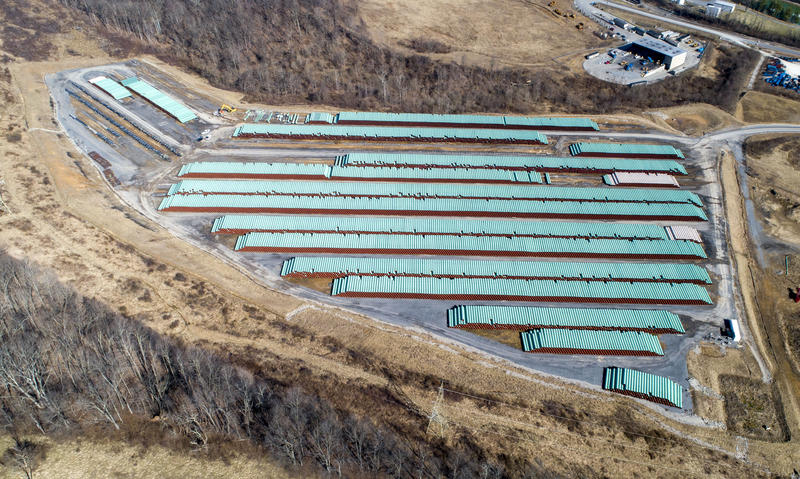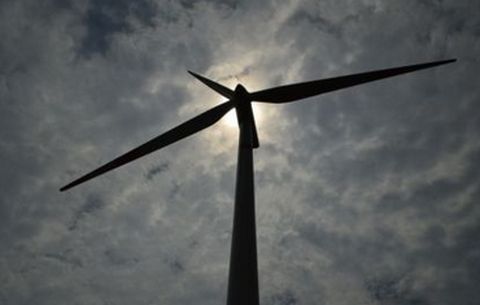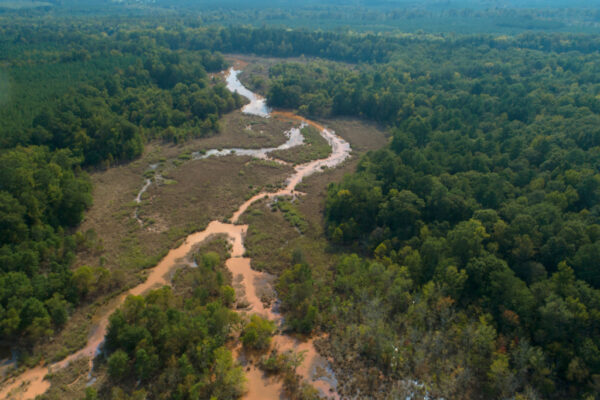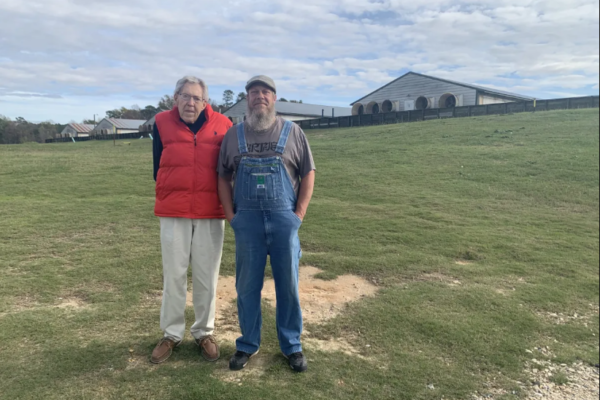By: Brittany Patterson, WV Public Broadcasting
August 29, 2019
On a recent hot, August weekend, about a dozen citizens spent three days along the route of the Mountain Valley Pipeline. Armed with cameras, smartphones and drones the volunteers traveled portions of the pipeline’s route under construction from Monroe to Doddridge counties.
“There was several things that we saw,” said Summers County resident and organic farmer Neal Laferriere.
Laferriere organized the three-day “violations blitz.” He said volunteers documented small problems like poorly-maintained erosion controls as well as much larger ones.
“Sediment-laden water in one situation was overflowing the controls and going directly into a creek,” he said. “So, definitely affecting the waterways of the state, which is a big violation.”
In total, the volunteers collected about 60 examples of what they deemed to be permit violations by the pipeline. Their efforts are part of a citizen monitoring program run by conservation group the West Virginia Rivers Coalition.
In 2012, West Virginia Rivers and Trout Unlimited created a program that trained volunteers how to monitor their local trout streams to determine if they were being affected by the state’s booming oil and gas industry. As more natural gas pipelines have been approved for construction in West Virginia, the program expanded to include pipeline construction monitoring.
“Pipeline construction releases a lot of sediment and sediment-laden water — muddy water — into what would otherwise be clear and pristine streams,” said Autumn Crowe, senior scientist with West Virginia Rivers. “That sediment, when it gets into the water body, it has multiple negative impacts on aquatic life and water quality.”
West Virginia Rivers collects the complaints and submits them to the West Virginia Department of Environmental Protection. The group worked with WVDEP’s enforcement department to develop the training materials.
Crowe said citizen monitoring, including this most recent “violations blitz,” fills an enforcement gap in West Virginia.
“What the vio-blitz was showing us is that there were multiple issues along the entire route that were not being addressed,” she said. “And if not for our volunteers, a lot of those issues would have gone unnoticed.”
Monitors observed this example of erosion control devices failing along the MVP’s route in Lewis County.
Regulation Challenges
As hydraulic fracturing or fracking has boomed in the Marcellus shale, so too has pipeline construction in Ohio, Pennsylvania, Virginia and West Virginia. Since 2015, federal regulators have approved the construction of 10 interstate natural gas pipelines through West Virginia.
The two most well-known projects — EQT’s Mountain Valley Pipeline and Dominion Energy’s Atlantic Coast Pipeline — are multi-billion dollar projects that are slated to carry billions of cubic feet of natural gas from Appalachia to the east coast and for export. Both projects have been besieged by lawsuits over issues ranging from forest crossings to water permits. Activists have locked themselves to equipment and protested in trees.
Unsafe construction practices have led to the temporary shutdown of some pipeline projects.
In the summer of 2017, construction of the Rover pipeline in West Virginia and Ohio and the Mariner East 2 pipeline in Pennsylvania was shut down by both state and federal authorities for haphazard construction.
Pennsylvania’s attorney general in March opened a criminal investigation related to the Mariner East pipelines. In December, Virginia’s Attorney General Mark Herring filed a civil suit against the Mountain Valley Pipeline citing more than 300 environmental violations.
The boom has challenged budget-constrained state and federal agencies, said Sara Gosman, an associate professor at the University of Arkansas School of Law.
“Just in terms of the resources that would be necessary to actually enforce compliance with all of our environmental laws, we don’t have those resources,” she said. “And it would frankly be very difficult to gather all those resources through government agencies.”
The regulatory challenge is further complicated by the fragmented way pipelines are regulated. Multiple federal agencies play a role as well as state environmental regulators in inspections and permitting.
The Federal Energy Regulatory Commission or FERC approves a pipeline’s route. The Pipeline and Hazardous Material Safety Administration is in charge of making sure it’s safely constructed and responding if there is an accident. The U.S. Army Corps of Engineers regulates construction impacts on wetlands and streams. And then state environmental agencies, like the West Virginia DEP, monitor the impacts of storm water on pipeline construction sites.
“I think anytime you have a fragmented legal system, it’s difficult for that system to work collectively well, and it also creates a lot of confusion among citizens who are wondering who to call,” Gosman said.
Hannah Wiseman, attorneys’ title professor and associate dean for environmental programs at Florida State University, said it’s only natural that as the buildout of natural gas infrastructure, including pipelines, has occurred and become more visible, citizen interest and concern has grown.
“Agencies have really had to run to catch up with the increased citizen attention as more wells are being drilled and fractured and as more pipelines are being built,” she said.
Resources remain an issue. In recent years Congress has given more money to the Pipeline and Hazardous Material Safety Administration for inspectors. They agency has approximately 160 pipeline safety inspectors covering construction across the county.
The West Virginia DEP has 10 positions in its Stormwater Construction Inspection Group, which is charged with inspecting all construction sites larger than one acre so as to ensure compliance with permits designed to prevent stormwater runoff. Currently, only eight of those positions are filled, according to WVDEP Spokesperson Terry Fletcher. The group has grown from three positions in 2005.
In an email, Fletcher said the agency is confident in its ability to ensure pipelines are in compliance with their permits and values input from citizens.
Laferriere, the citizen pipeline monitor, disagrees. The Mountain Valley Pipeline alone traverses 200 miles in West Virginia and he fears the agency doesn’t have the capacity to monitor it and others across the state.
“They’re not doing a good enough job,” he said. “If we can go out and in three days find 60 violations here in West Virginia with a handful of people, how many violations, how many things are we missing? How many watersheds are being affected by this project that nobody’s aware of?”
In response, Fletcher noted WVDEP, as a state agency, “cannot simply create permanent, full-time positions without first having allocated funding for new positions, and then receiving approval from the state Division of Personnel.”
Gosman, at the University of Arkansas School of Law, said it’s likely citizen concerns over natural gas pipelines will continue to grow, and not just over whether they are being constructed safely, but if they’re needed at all, and whether they’re being proposed for the right places.
“We need to think holistically about pipelines, about where they’re placed, what it means to have an accident in that particular place,” she said. “What it means to have issues around stormwater and wetlands impacts in that particular place over the long term, rather than treat each of these particular issues construction, operation, emergency response as being separate.”
According to WVDEP’s online system, inspectors have investigated just a handful of the citizen complaints. No official violation notices have been issued.





